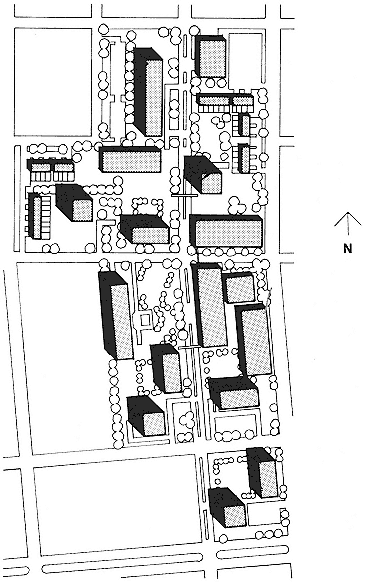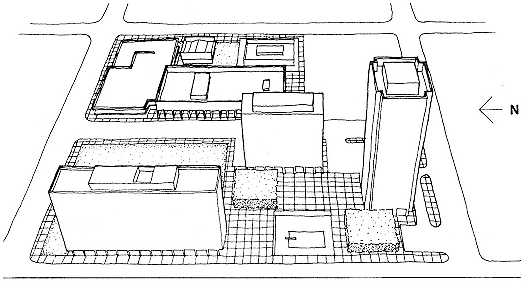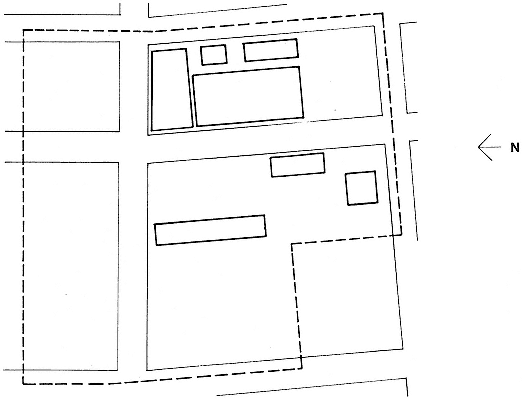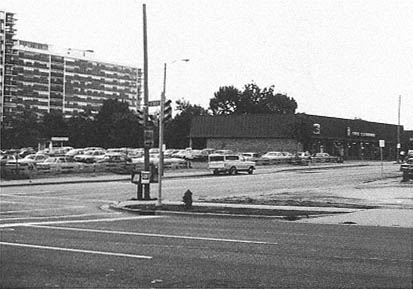The Vision of Towers in a Park
The ideal of functionalist theory, Euro-American style, may be seen in Milwaukee's Juneau Village development, which, once constructed, demonstrated the theory's failure. The development followed in the wake of the federal bulldozers that leveled poor and working-class neighborhoods near downtown so they could be replaced with middle- and upper-income enclaves. To entice the new population group downtown, the functionalist ideal of highrise towers in a parklike setting was chosen, with an adjacent pedestrian-oriented shopping center to offer the amenities of a village and to minimize trips beyond the safety of the enclave.
Functionalist theory argues that because automobiles interfere with human activities, vehicles should be separated from pedestrian areas. In extreme cases this separation means peripheral highways and peripheral parking. In the case of Juneau Village, it meant closing two streets and placing automobiles in underground or structured lots largely masked from public view yet connected to both housing and shopping precincts. The development is located within walking distance of downtown offices. The initial phase included three towers and a shopping center.
Juneau Village was envisioned as a step toward a functionalist revitalization of Milwaukee's downtown. It was not potent enough, how-

16.
Original scheme for Juneau Village, designed by Solomon,
Cordwell and Associates, Chicago, 1965–1967.
ever, to sustain even its own completion, let alone to lead or give impetus. No one seems to have had the necessary conviction to will the remainder of the development into being. And, a point we shall stress throughout the chapters that follow, the architecture itself offered no clues to the relation of the development to existing neighborhoods or to the ways succeeding developments should respond to it. The architectural vocabulary was alien to the past and too narrow to guide the future.
As built, the initial stage of Juneau Village was not large enough to restructure its context. Then too, the design was not appealing enough to stimulate a new market of renters or buyers. Although its failure to be realized is most easily blamed on economic conditions and middle-class

17.
Bird's-eye view of the part of Juneau Village that was actually built.

18.
Juneau Village, plan of the section actually built, showing adjacent areas thatwere cleared as
part of the urban renewal effort.

19.
Part of Juneau Village, with shops seen to the right, and part of the site that
was used for twenty years for incidental parking.
prejudices, there is another explanation: Juneau Village failed both to recognize its context and to accept a role as catalyst in shaping the character and future of its American neighborhood. In short, it was inert, a seed on foreign soil. The transplanted European functionalist vision was not quite right for this American context, nor did it have sufficient conviction to motivate and shape a following.
For years the bulldozed areas around this early stage of Juneau Village lay empty. When it became clear that the village offered no model for subsequent development, pragmatic, visionless alternatives were approved and built in the form of suburban-style garden apartments. That Juneau Village usually is fully occupied testifies not to its actual or conceptual appropriateness or to its potency but to the raw need for housing.
Such transplants of European ideals need not inevitably fail. Our message, which we shall repeat, is that the implanted foreign idea will not succeed on its own merits but must be customized for its American context and must have the power to shape a subsequent context. These processes are discussed in chapter 3.